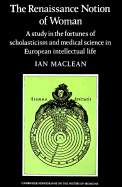 The Renaissance Notion of Woman
The Renaissance Notion of Woman Summary
The names of Renaissance writers are given where possible in their vernacular form, except in cases where the Latin form is better known or used in library catalogues (e.g. Cornelius a Lapide, Justus Lipsius). For less well-known figures, the dates of birth and death, where known, have been given, and the date of the earliest recorded edition of their works which I could find. The major authorities consulted for this information have been Zedler's Universallexikon, Hirsch's Biographisches Lexikon der hervorragenden Ärzte, Cosenza's Biographical and bibliographical dictionary of the Italian humanists, R.J. Durling's Catalogue of sixteenth-century printed books in the National Library of Medicine, The Oxford dictionary of the Christian Church, ed. Cross and Livingstone, and C. H. Lohr's alphabetical list of Renaissance Latin Aristotle commentaries (Studies in the Renaissance, XXI (1974), 228–89; Renaissance Quarterly, XXVIII (1975). 689–741; XXIX (1976), 714–45; XXX (1977). 681–741). The first two authorities mentioned here are not wholly reliable, and the dates have been included more to indicate the approximate period of composition and publication of a text than in the belief that they are well established. I have occasionally used standard abbreviations (e.g. PL = Patrologiae cursus completus, series latino, ed. J. P. Migne, Paris, 1844–1904; PG = Patrologiae cursus completus, series graeca, ed. Migne, Paris, 1857–1904). In the case of long quotations, the original text is given in the appendix; the original text of short quotations is given in the endnotes.
- Type
- Chapter
- Information
- The Renaissance Notion of WomanA Study in the Fortunes of Scholasticism and Medical Science in European Intellectual Life, pp. vii - viiiPublisher: Cambridge University PressPrint publication year: 1980
